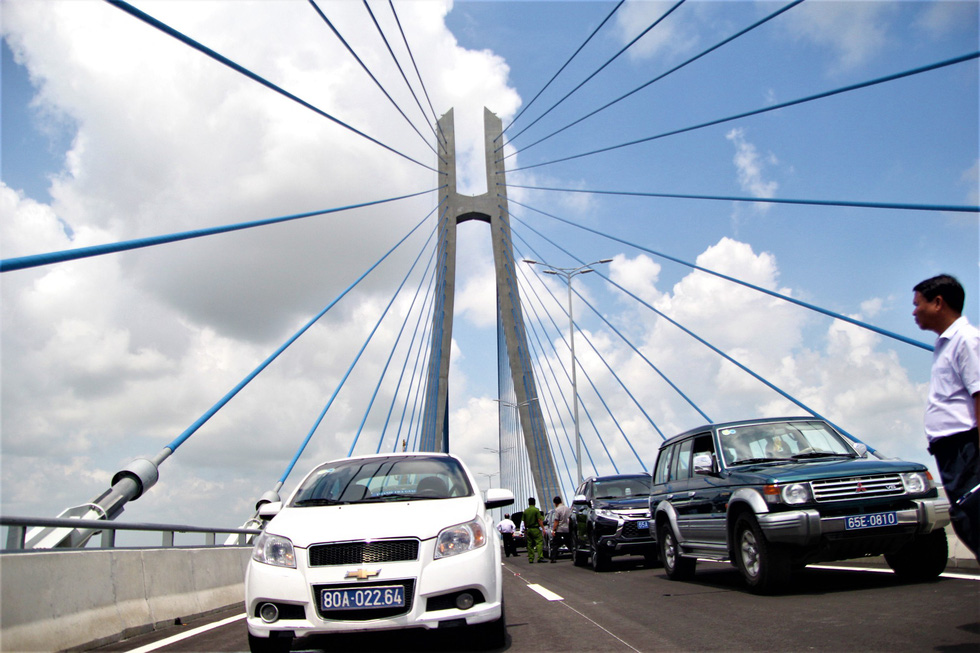The ferry services across Hau (Back) River in Vietnam’s Mekong Delta is nearing its final run after nine decades of service as a recently constructed bridge opens to traffic tomorrow, May 19.
Days are numbered for the Vam Cong ferry service, which has been transporting people and vehicles of all kinds between Dong Thap and An Giang Provinces via the Hau River for nearly a century since its first run in the 1920s.
Located just a short distance from the ferry route is the newly built Vam Cong Bridge, scheduled to open this Sunday, which also crosses the Hau Driver, linking Dong Thap and the Mekong Delta metropolis of Can Tho, which borders An Giang.
While the bridge is not a perfect replacement for the ferry crossing, authorities have stated that they expect the new structure to meet the needs of those who commute between Can Tho, An Giang and Dong Thap, making the ferry service, its ten vessel fleet, and staff redundant.
 |
| A Vam Cong ferry carries passengers across Hau River, with the bridge to replace it seen in the background, Photo: Mau Truong / Tuoi Tre |
As the ferry’s final voyage nears, the feelings of nostalgia have cast a gloomy blanket over those who have spent decades maintaining the route.
Nguyen Van Dong, who has spent the past 30 years total working as a ferry captain, nine of which were for Vam Cong, shared that his early days of working for the service included a month of learning the river’s flow and techniques to keep the boat under control.
This isn’t the first time his route has been shut down. He was originally transferred to Vam Cong when the previous route he worked was replaced by a bridge. But still, it’s a feeling he says he just can’t get used to.
“Words of goodbye are always hard to say, especially to people or things that have become part of your daily life,” said Dong as he held back tears.
 |
| Nguyen Van Dong, a ferry captain for the Vam Cong Group. Photo: Mau Truong / Tuoi Tre |
Other workers who have devoted their lives to the Vam Cong ferry crossing expressed a similar sadness, explaining they’d miss the ferry’s bustling atmosphere during rush hour and public holidays.
“I don’t know how to put this, but it feels like something is missing,” 50-year-old ferry conductor Tran Viet Dung said.
“We have been through ups and downs together, so separation is hard for me to accept,” said Nguyen Duy Tan, another ferry conductor with ten years of experience at Vam Cong.
“It’s not the salary that is valuable, but the memories that count,” said cleaner Phan Van Do.
People who live or make a living in the surrounding area also feel a sense of nostalgia for the ferry line, particularly 75-year-old Tran Thi Yen, the owner of a small coffee shop near the Vam Cong ferry crossing.
“I’m not ready to say goodbye to a good friend I’ve had for 20 years,” she said.
 |
| A worker writes about the Vam Cong ferry crossing in a diary. Photo: Mau Truong / Tuoi Tre |
Le Van Muoi, the director of the Vam Cong ferry group, said Vam Cong’s ferries and workers will be transferred to other ports after the official opening of the new bridge.
Muoi himself has his own good memories, having worked on ferries since the late 80s and serving as director of the Vam Cong ferry for the past ten years.
“I’m used to goodbyes and I think the end of something might be a good start of something else,” he said.
 |
| Automobiles of local officials are parked along the bridge. |
Stretching 2.97 kilometers, the Vam Cong Bridge is designed with a total of six lanes, four reserved for automobiles and two for motorcycles.
Construction started in September 2013, with investment totaling US$271 million, which was funded by South Korea’s ODA (official development assistance) and corresponding capital from the Vietnamese government.
Cuu Long CIPM serves as the developer on behalf of Vietnam’s transport ministry, while the project is conducted by South Korean contractors, namely the Joint Venture of Dasan - Kunhwa – Pyunghwa and the Joint Venture of GS Engineering & Construction Corp and Hanshin.
The construction was first delayed in November 2017 after several fractures were found on the steel girders at the top of several abutments.
The repair work was expected to be finished in 2018 so that the bridge could be put into operation later the same year. But even the repair faced challenges, forcing contractors to delay its inauguration until this month.
Like us on Facebook or follow us on Twitter to get the latest news about Vietnam!


















































